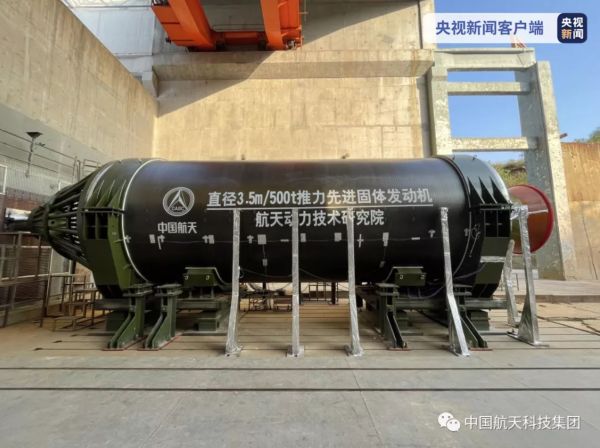China just test-fired a massive solid-fueled rocket

China has test fired a huge new solid rocket motor, creating more propulsion options for the country’s growing space activities.
The rocket motor was ignited Tuesday (Oct. 19) at a site near Xi'an city in north China, firing for 115 seconds, creating a tremendous trail of flame and exhaust.
The new motor was developed by the Academy of Aerospace Solid Propulsion Technology (AASPT) which belongs to the China Aerospace Science and Technology Corporation (CASC), the country's main space contractor.
The motor has a diameter of 11.48 foot (3.5 meters)1 and a maximum thrust of 1,00,000 pounds-force (500 tons) is powered by 330,000 pounds (150 tons) of solid fuel. A CASC statement said it is the most powerful solid rocket motor with the largest thrust in the world so far.
Related: The latest news about China's space program
It also proved multiple cutting-edge technologies, according to CASC, including a high-performance fiber composite shell, an integral-casting combustion chamber and an oversized nozzle, to make it a highly advanced rocket engine.
"Testing is very successful. We have tested all the parameters including the 500-ton thrust that worked 115 seconds," said Ren Quanbin, president of AASPT.
Sign up for the Live Science daily newsletter now
Get the world’s most fascinating discoveries delivered straight to your inbox.
"We are at the international advanced level in the field of large solid rocket engines. Next, we will develop a 1,000-ton solid rocket engine to provide stronger thrust for China's carrier rockets in the future," Ren told CCTV.
CASC says the rocket motor is expected to be used with heavy-lift rockets to meet various demands for launch vehicles during space missions like crewed Moon landings and deep space exploration. China is already developing the Long March 9 and another large rocket for launching astronauts for crewed lunar missions, neither of which include solid boosters.
China has made big progress on solid propellant rockets in recent years, including the successful development and launch of the Long March 11, which can launch from land or sea. AASPT also tested a (3.2 m) diameter solid engine in December 2020.
However the new engine is much larger and could be added to launch vehicles to produce extra thrust. It could also be used by CASC commercial spinoff China Rocket, which develops Jielong solid rockets for launching commercial satellites.
China is also planning to launch its first rocket which combines liquid propellant core stages with solid side boosters. The Long March 6A could launch before the end of the year.
CASIC, another gigantic Chinese state-owned enterprise similar to CASC and with its own space aspirations, is also developing small and large solid rockets.
This comes at a time when many countries and companies, including China itself, are developing reusable liquid propellant rockets. After the first stages have done their job, engines for these new launchers are able to reignite to guide the first stage back towards a landing area and burn once more to make a powered descent and vertical landing. In this way the rockets can be recovered and reused, reducing launch costs.
Solid rockets however cannot be controlled in the same way, and once ignited they burn until all propellant is used up. They are however more simple than liquid rockets and offer their own advantages in cost and production.
China's new solid rocket motor It is not the largest nor most powerful solid fuel engine ever tested, however. In the 1960s, Aerojet developed and test fired the SL-260, with “260” referring to its diameter in inches, or 21.60 ft (6.60 m).
It was designed for NASA to demonstrate the feasibility of utilizing large SRMs for space exploration, but was not used.
Follow us on Twitter @Spacedotcom or Facebook.

Andrew is a freelance space journalist with a focus on reporting on China's rapidly growing space sector. He began writing for Live Science sister site Space.com in 2019, and he also writes for SpaceNews, IEEE Spectrum, National Geographic, Sky & Telescope, New Scientist and others. Andrew first caught the space bug when, as a youngster, he saw Voyager images of other worlds in our solar system for the first time. Away from space, Andrew enjoys trail running in the forests of Finland.










